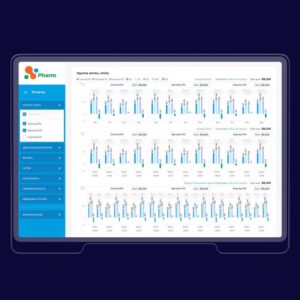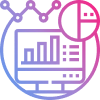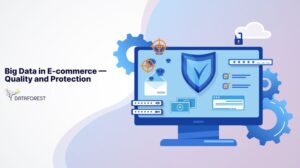Data-Driven
Finance
Innovative use of technology to improve and automate the delivery of financial services.
AI-Driven Fintech Services
Provide Personalized Investment Options
Our customized solutions are designed to address your specific business needs.
Transforming Financial Data with Real-Time Integration
Have you ever been disrupted by delays in critical processes? The solution optimizes data preparation.
Legacy System Integration
Have you faced challenges integrating legacy systems with modern applications? Or struggled with API and cloud mergers? Our solution ensures data flow and compatibility.
Fraud Detection
Are you afraid that fraudulent activities will waste your work? The solution prevents fraudulent activities, safeguarding financial assets.
Financial Services Pricing with Data-Driven Analysis and Reporting
Are you having difficulty adjusting lending rates? With our solution, you’ll make immediate, data-driven pricing decisions.
Leveraging Predictive Analytics for Accurate Demand Forecasting in Finance
Need help understanding how to calculate an investment demand? The solution creates and optimizes your investment strategies.
Don’t make the process harder than it is.
Jack Welch, American business executive
Benefits of Data-Driven Finance
01 Informed and timely decisions
for investments.
02 Reducing manual efforts and
improving operational efficiency.
03 Acting on opportunities
and threats swiftly.
04 Higher customer satisfaction
and loyalty.
05 Greater accuracy in reporting
and analytics.
06 Gaining immediate insights into market trends.
07 Reducing the risk of non-compliance
and penalties.
08 Enhancing overall
operational efficiency.
Boost Work Efficiency and Accuracy with Expert Machine Learning Support.
Get in Touch Now!
Cases of Using Artificial Intelligence and Machine Learning
Check out a few case studies that show why VOLTERA will meet your business needs.
Stock relocation solution
The client was faced with the challenge of creating an optimal assortment list for more than 2,000 drugstores located in 30 different regions. They turned to us for a solution. We used a mathematical model and AI algorithms that considered location, housing density and proximity to key locations to determine an optimal assortment list for each store. By integrating with POS terminals, we were able to improve sales and help the client to streamline its product offerings.

Client Identification
The client wanted to provide the highest quality service to its customers. To achieve this, they needed to find the best way to collect information about customer preferences and build an optimal tracking system for customer behavior. To solve this challenge, we built a recommendation and customer behavior tracking system using advanced analytics, Face Recognition, Computer Vision, and AI technologies. This system helped the club staff to build customer loyalty and create a top-notch experience for their customers.

Performance Measurement
The Retail company struggled with controlling sales and monitoring employees’ performance. We implemented a software solution that tracks sales, customer service, and employee performance in real-time. The system also provides recommendations for improvements, helping the company increase profits and improve customer service.

Supply chain dashboard
The client needed to optimize the work of employees by building a data source integration and reporting system to use at different management levels. Ultimately, we developed a system that unifies relevant data from all sources and stores them in a structured form, which saves more than 900 hours of manual work monthly.

Michelle Nguyen
Senior Supply Chain Transformation Manager Unilever, World’s Largest Consumer Goods Company
View case study →

Steps
Towards Good Development
These data engineering development stages ensure that solutions are well-designed, thoroughly tested, and aligned with business objectives.
Step 1 of 7
Initial Project Assessment
and Definition
In the early phases of our data engineering development process, we engage in a free consultation to gauge project compatibility. During the discovery and feasibility analysis, we adapt to your needs, whether it’s high-level requirements. We gather information to define project scope through discussions, including feature lists, data fields, and solution architecture. We craft a project plan to guide our progress, reflecting our dedication to achieving project goals and delivering effective data engineering solutions.

Step 2 of 7
Discovery
So, you have finally decided that you are ready to cooperate with VOLTERAGROUP.
The discovery stage involves delving into the details of the project. Data engineers gather requirements, analyze existing systems, and understand the needs of the business. This step is crucial for laying the groundwork for development, as it ensures that the project aligns with business goals and user needs.

Step 3 of 7
Tech Design and Backlog Planning
In this stage, the technical architecture and design of the solution are formulated. Data engineers plan how data will be collected, stored, processed, and presented. Simultaneously, the project backlog is created — a list of tasks and features to be developed. This backlog is prioritized, ensuring that high-priority items are addressed first.

Step 4 of 7
Development Based on Sprints
Development takes place in iterative cycles known as sprints. During each sprint, the development team tackles tasks from the backlog. The team focuses on coding, testing, and integrating the components. At the end of each sprint, a functional part of the solution is ready for review.

Step 5 of 7
Project Wide QA
Quality Assurance is an ongoing process that permeates the entire project development lifecycle. It ensures rigorous testing, identification, and resolution of any bugs or issues to guarantee the solution’s smooth operation, compliance with requirements, and alignment with quality standards. The solution is prepared for release as QA activities persist and necessary adjustments are continuously implemented.
Step 6 of 7
Deployment and Rollout
The deployment phase involves releasing the solution to the production environment, making it accessible to users. It requires careful planning to ensure a seamless transition and minimal disruption. After deployment, the rollout phase begins, involving training for users and ongoing support to address any hiccups.

Step 7 of 7
Support and Continuous Improvement
In the final stages, we ensure ongoing excellence. We guarantee optimal performance and swiftly address any issues. Simultaneously, our feedback process empowers us to continuously enhance the solution based on user insights, aligning it with evolving needs and driving continuous innovation.
What Data Science technologies do we use?
Pandas
SciPy
TensorFlow
Numpy
ADTK
DBscan
G. AutoML
Keras
MLFlow
Natural L. AI
NLTK
OpenCV
Pillow
PyOD
PyTorch
FB Prophet
SageMaker
Scikit-learn
SpaCy
XGBoost
YOLO







